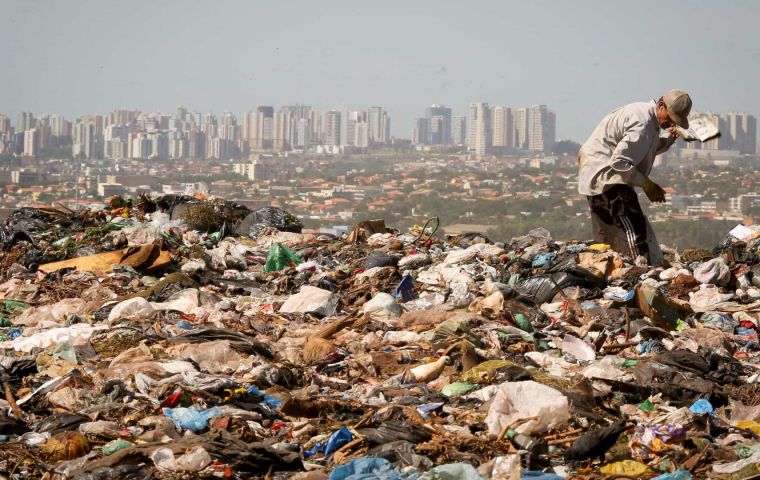MercoPress. South Atlantic News Agency
Brazil: Millions could fall into poverty unless proper investing is done
 Green technologies are gaining space, and this affects demand, one of the authors of the World Bank's study found
Green technologies are gaining space, and this affects demand, one of the authors of the World Bank's study found Millions of Brazilians could be thrown into extreme poverty in the next few years due to weather-related phenomena, a report released last week by the World Bank showed.
According to the Country Climate and Development Report (CCDR) for Brazil, between 800 thousand and 3 million people could fall into that category, although such a scenario can be avoided through investments, the study explained.
The document, which assesses policies and strategies for Brazil to achieve its climate and development goals, shows that droughts, floods, and urban inundations result in annual losses of BRL 13 billion, equivalent to 0.1% of the GDP in 2022.
Stephane Hallegate, a climate change consultant at the World Bank and co-author of the report, notes that Brazil's significant inequalities mean that the poor are more vulnerable to the impacts of disasters and climate change. However, he suggests that this situation can be reversed with increased investment.
“Investing in people and in infrastructure in less developed areas is important to make this low-income population more resilient. This will help them get out of poverty and contribute to the economic growth of the country,” he says.
The CCDR is based on the goals that Brazil set for itself in the Paris Agreement and in editions of the Conference of the Parties (COPs). To achieve these goals, the report recommends actions on four fronts: structural reforms and productivity-enhancing measures, comprehensive economic policies for resilient and low-carbon growth, sectoral policies, and investment packages, besides actions to secure financing for the necessary investments.
By reaching these goals, it is believed that Brazil can achieve green development and end illegal deforestation by 2028, reduce greenhouse gas (GHG) emissions by 50% by 2030, and reach zero net emissions by 2050.
Although Brazil has drastically reduced the share of people living in extreme poverty over the past three decades, the number of individuals in this condition increased in 2015 and 2016, reaching 5.8% of the population in 2021.
According to the report, the increase in extreme poverty could range from 0.4% to 1.3% by 2030, depending on the development model chosen. Climate-related reductions in agricultural yields, extreme weather phenomena, changes in food prices, health impacts, and reduced labor productivity due to heat are some of the factors that could lead to this scenario.
The CCDR suggests, however, several measures so that Brazil can meet its commitment to zero illegal deforestation by 2028 without harming development. Among the measures is the support for sustainable economic activities based on soil and forests.
For the study's authors, the expansion of protected areas, including indigenous territories, would improve forest governance by creating opportunities for payments for caring for nature, such as ecotourism, sustainable harvesting of non-timber forest products, and agroforestry systems. The creation of Legal Forest Reserves, as required by the Brazilian Forest Code, would also provide opportunities for income generation and inclusive growth.
Climate change is altering the temperature patterns and rainfall regime in Brazil, resulting in less water availability and prolonged droughts. According to the CCDR, these problems will worsen over time and could have serious consequences for agriculture, water supply in cities, transportation infrastructure, and hydroelectric power generation, affecting economic competitiveness.
The impact projected by the study of a possible tipping point in the Amazon on Brazilian GDP by 2050 would be approximately BRL 920 billion. The tipping point is a kind of collapse and would occur when the quantity of trees is no longer sufficient to generate the humidity necessary to sustain the forest.
Although Brazil is one of the ten largest emitters of greenhouse gases in the world, the profile of its emissions differs from that of other countries. Between 2000 and 2020, 76% of the country's emissions originated from land use change, including deforestation and agriculture, compared to 18% for global emissions. On the other hand, almost half of Brazil's energy supply, including more than 80% of its electricity, comes from renewable sources, compared to world averages of about 15% to 27%.
Also, according to the CCDR, the prevalence of renewable energy and Brazil's potential for producing green goods and services puts the country at a competitive advantage in supplying the products needed for decarbonization (removal of carbon dioxide from the atmosphere), including green minerals, green hydrogen, and manufactured green products. Prioritizing efforts to curb deforestation would allow Brazil to not only preserve its ecosystems but gradually decarbonize other productive sectors.
“The sustainable use of natural resources is becoming a requirement for competitiveness in international markets. Green technologies are gaining space, and this affects demand. For example, electric vehicles are growing rapidly. Brazil has demonstrated a capacity to innovate and lead in new technologies and can benefit from this trend, ” concludes Hallegate.
(Source: Agencia Brasil)




Top Comments
Disclaimer & comment rulesCommenting for this story is now closed.
If you have a Facebook account, become a fan and comment on our Facebook Page!